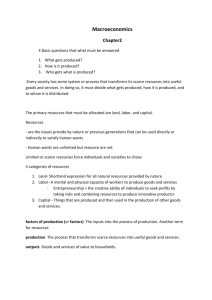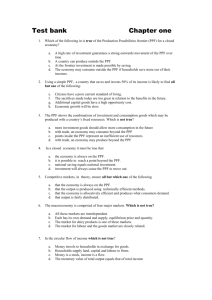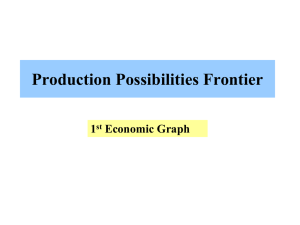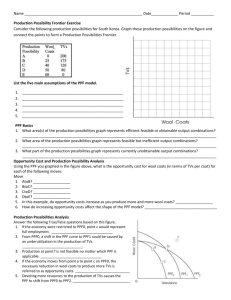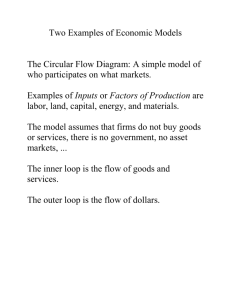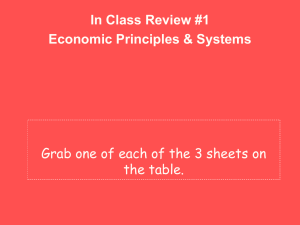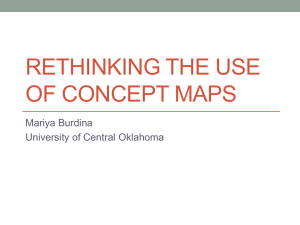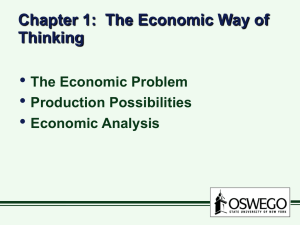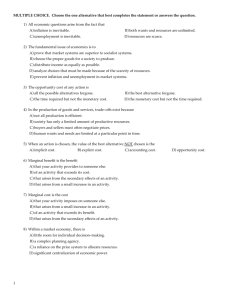chapter 2 - MBA Program Resources
advertisement
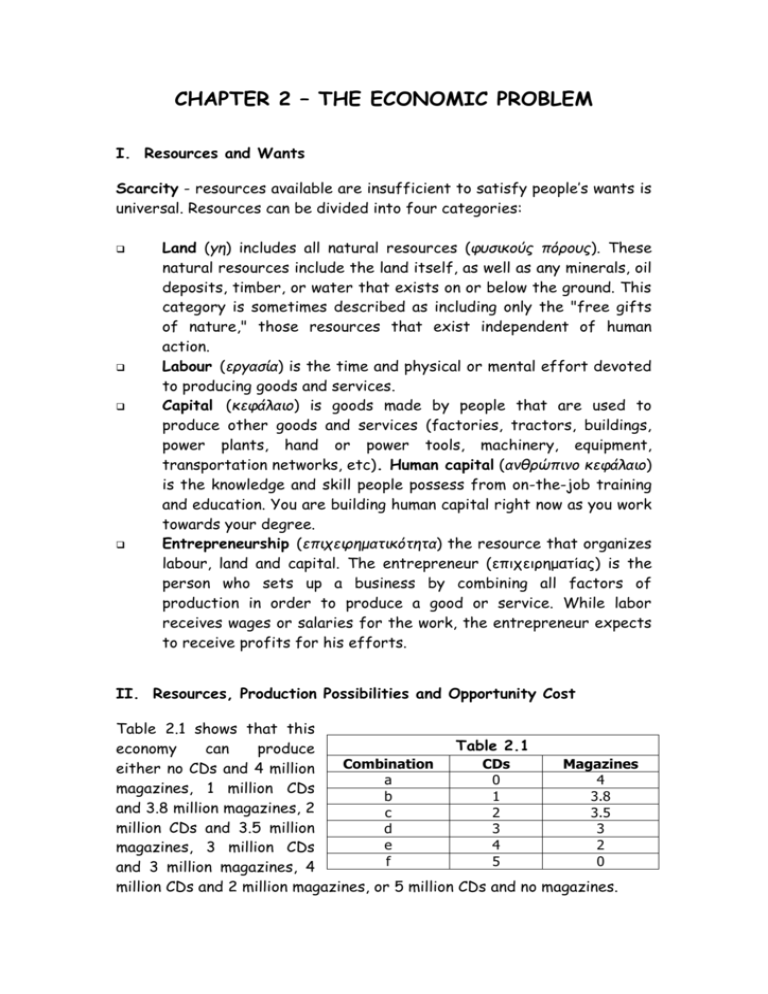
CHAPTER 2 – THE ECONOMIC PROBLEM I. Resources and Wants Scarcity - resources available are insufficient to satisfy people’s wants is universal. Resources can be divided into four categories: Land (γη) includes all natural resources (φυσικούς πόρους). These natural resources include the land itself, as well as any minerals, oil deposits, timber, or water that exists on or below the ground. This category is sometimes described as including only the "free gifts of nature," those resources that exist independent of human action. Labour (εργασία) is the time and physical or mental effort devoted to producing goods and services. Capital (κεφάλαιο) is goods made by people that are used to produce other goods and services (factories, tractors, buildings, power plants, hand or power tools, machinery, equipment, transportation networks, etc). Human capital (ανθρώπινο κεφάλαιο) is the knowledge and skill people possess from on-the-job training and education. You are building human capital right now as you work towards your degree. Entrepreneurship (επιχειρηματικότητα) the resource that organizes labour, land and capital. The entrepreneur (επιχειρηματίας) is the person who sets up a business by combining all factors of production in order to produce a good or service. While labor receives wages or salaries for the work, the entrepreneur expects to receive profits for his efforts. II. Resources, Production Possibilities and Opportunity Cost Table 2.1 shows that this Table 2.1 economy can produce Combination CDs Magazines either no CDs and 4 million a 0 4 magazines, 1 million CDs b 1 3.8 and 3.8 million magazines, 2 c 2 3.5 million CDs and 3.5 million d 3 3 e 4 2 magazines, 3 million CDs f 5 0 and 3 million magazines, 4 million CDs and 2 million magazines, or 5 million CDs and no magazines. The production possibilities frontier (PPF – καμπύλη παραγωγικών δυνατοτήτων) marks the boundary between combinations of goods and services that can be produced and combinations that cannot. A production possibilities diagram that holds constant the production of all goods, except for magazines and CDs, is illustrated in Figure 2.1 below and in the textbook. The PPF line separates attainable combinations of production (all points inside and on the line) from unattainable combinations (all points beyond the line). Figure 2.1 - The P.P.F. Magazines 5 a 4 b c d 3 e 2 1 f 0 0 1 2 3 4 5 6 CDs Production efficiency (every point on the PPF) means that more of one good cannot be produced without decreasing production of another good. Production efficiency occurs only when production takes place on the PPF line. Because another good must be given up, there is a tradeoff. The opportunity cost of an action is the highest valued alternative foregone. On the PPF, the opportunity cost of producing more of one product (for example, a magazine) is the output of the other good that must be foregone (for example, CDs). The opportunity cost of a magazine is the number of CDs that must be foregone per magazine; hence, opportunity cost is a ratio. The opportunity cost of a CD is the inverse of the opportunity cost of a magazine. In the figure below, the economy can Magazines increase the production of CDs only by decreasing the production of magazines. 4 Opportunity cost of moving from B to C: To produce 1 more CD (from 1 to 2), we must give up 0.3 magazines (3.8 - 3.5) B 3.8 0.3 3.5 C 1 0.5 3 Opportunity cost of moving from C to D: To produce 1 more CD (from 2 to 3), we must give up 0.5 magazines (3.5 - 3) D 1 2 1 0 1 2 3 4 5 CDs Table 2.1(a) – Calculation of the opportunity cost CDs Magazines 0 1 2 3 4 5 4 3.8 3.5 3 2 0 Opportunity cost of CDs in terms of magazines 4 - 3.8/1 - 0 = 0.2 3.8 – 3.5 / 2 – 1 = 0.3 3.5 – 3 / 3 – 3 = 0.5 3–2/4–3=1 2–0/5–4=2 Opportunity cost of magazines in terms of CDs 1 – 0 / 4 – 3.8 = 5 2 – 1 / 3.8 – 3.5 = 3.3 3 – 2 / 3.5 – 3 = 2 4–3/3–2=1 5 – 4 / 2 – 0 = 0.5 Table 2.1(a) shows the calculation of opportunity cost in terms of magazines (how many magazines we must give up in order to produce more CDs) and CDs (how many CDs we must give up in order to produce more magazines). For example, at point B we are producing less CDs and more magazines than at point C. If we choose point D over point C, the 1 million CDs will cost 0.5 million magazines. We can also work out the opportunity cost of choosing point C over point D. If we move from point D to point C, the quantity of magazines increases by 0.5 million and the quantity of CDs produced decreases by 1 million. So, if we choose point C over D, the additional 0.5 million of magazines cost 1 million CDs. Opportunity cost is a ratio (λόγος ή κλάσμα). It is the decrease in the quantity produced of one good divided by the increase in the quantity produced of the other good as we move along the PPF. Because opportunity cost is a ratio, the opportunity cost of producing CDs is equal to the inverse (αντίστροφο) of the opportunity cost of producing magazines. You can also notice that as production of CDs increases, the opportunity cost of CDs in terms of magazines increases (0.2 magazines for the first unit, 0.3 for the second, 0.5 for the third and so on). The same thing happens when the production of magazines increases: the opportunity cost of magazines in terms of CDs increases (0.5 CDs for the first 2 units, 1 CD for the third unit and so on). This is called the principle of increasing cost. This is so because different resources are not homogeneous. That is, the economic resources of the economy are not equally suitable in the production of CDs and magazines. For example, in producing the first million of CDs, the economy uses those resources that are most efficient (suitable) in CD production and less efficient in magazine production. So, the amount of magazines given up to produce the first million of CDs is very little (0.2 million magazines). But as we continue to increase the production of CDs by decreasing the production of magazines, the resources that must be used to produce CDs are less and less productive in CD production and more and more productive in magazine production. As a result, the cost of increasing CD production, in terms of reduced magazine production, increases. Along the PPF, producing more of a good has increasing opportunity costs. The concave (κοίλη) shape of the PPF reflects increasing opportunity costs. Most activities in the real world are subject to increasing opportunity costs. III. Using Resources Efficiently Marginal cost (MC) is the opportunity cost of producing one more unit of a product. The marginal cost (οριακό κόστος) of producing a good rises because the opportunity cost of a product rises as more of a product is produced. The marginal cost curve is upward sloping as illustrated in Figures 2.2 and 2.4 in the textbook. The marginal benefit (MB) of a good is the maximum that someone is willing to pay for one more unit of it. 1. The principle of decreasing marginal benefit holds that as more of a product is produced, its marginal benefit decreases. 2. The marginal benefit (οριακό οφέλημα) curve is downward sloping as illustrated in Figures 2.3 and 2.4 in the textbook. Resources are used efficiently when they are producing the goods and services valued most highly. 1. Efficiency is attained when the quantity of the good produced sets the marginal benefit equal to the marginal cost. 2. In Figure 2.4 in the textbook, the efficient quantity of CDs is 3000 units per year. IV. Economic Growth Economic growth is the expansion in production. It is indicated by a rightward shift (μετατόπιση προς τα δεξιά) of the PPF, which means that the economy can increase production of one good without decreasing the production of other goods and services. Two factors cause economic growth: technological progress and capital accumulation: Technological progress is the development of new goods and services and better ways to produce them. Capital accumulation refers to growth in a society’s capital resources. The greater the capital accumulation and/or technological progress, the more rapidly the PPF expands, that is, the more rapid is economic growth. Figure 2.3 Consumption goods At point A in Figure 2.3, society has only consumption goods and services in the current period (now). Point C, however, provides the possibility of a larger quantity of consumption goods and services in the future because of capital 18 A B 15 C 10 D 5 E 0 2 4 6 8 Capital goods Nations that willingly choose to devote more of their resources to capital accumulation or improving their technology (such as Hong Kong) grow more rapidly than nations that choose not to pay the cost and thus devote fewer resources (the European Union) to such purposes. Consumption goods accumulation since the economy produces 10 units of consumption goods and 4 units of capital goods. In producing at point C and increasing the economy’s capital, the economy’s production capabilities (παραγωγικές δυνατότες) increase and provide an increased output of consumer goods and services in the future. If society maintains such a mix of capital and consumption goods production over time, consumption goods and services production will exceed the 18 units of consumption goods and services produced in the current period in selecting point A. Economic growth is costly: society must give up purchases of consumption goods and services now if it is to increase its supply of capital and expand production capabilities. So, people must be willing to have fewer goods and services now, that is, they must be willing to save (αποταμιεύουν) so that resources can be used in the current period to produce capital goods. Figure 2.4 shows that economic growth is faster if more resources are devoted to the production of capital goods; the production capabilities of the economy expand as more consumption and capital goods are produced. Figure 2.4 - Economic growth 30 25 18 15 B 10 if combination C is chosen C 5 0 D 2 4 6 if combination D is chosen 8 16 20 Capital goods V. Gains From Trade People’s abilities differ; as a result, different people have different opportunity costs of producing a particular good or providing a particular service. A person or a country has a comparative advantage (συγκριτικό πλεονέκτημα) in producing something if that individual or country can produce it at a lower opportunity cost than anyone else. In terms of a PPF diagram, the opportunity cost of producing a good is related to the slope of the PPF (at the point of production). Let's examine an example illustrating the concept of comparative advantage. Suppose that the U.S. and Cyprus only produced two goods: CD players and food. Figure 2.5 below represents production possibilities curves for these two countries. (These numbers are obviously hypothetical....). To determine who has a comparative advantage, though, it is necessary to calculate the opportunity cost for each good from the PPF of each country. The opportunity cost of one unit of CD players in the U.S. is 2 units of food. In Cyprus, the opportunity cost of one unit of CD players is 1.3 units of food. Thus, Cyprus has a comparative advantage in CD player production. The U.S. however, has a comparative advantage in food production since the opportunity cost of a unit of food is 0.5 CD players in the U.S., but is 0.75 CD players in Cyprus. If each country specializes in producing the good in which it has a comparative advantage, it can acquire the other good through trade at a cost that is less than the opportunity cost of production in the domestic economy. For example, suppose that the U.S. and Cyprus agree to trade one unit of CD players for 1.6 units of food. The U.S. gains from this trade because it can acquire a unit of CD players for 1.6 units of food, which is less than the opportunity cost of producing CD players domestically. Cyprus gains from this trade since it can trade one CD player for 1.6 units of food while it only costs Cyprus 1.3 units of food to produce a unit of CD players. If each country produces only those goods in which it has a comparative advantage, each good is produced in the global economy at the lowest opportunity cost. This results in an increase in the level of total output. Figure 2.5 Cyprus Opportunity cost of 1 CD player is 2 units of food (200/100). 100 Opportunity cost of 1 unit of food is 0.5 CD players (100/200). US has a comparative advantage in food 200 Food CD players CD players U.S. 75 Opportunity cost of 1 CD player is 1.3 units of food (100/75). Opportunity cost of 1 unit of food is 0.75 CD players (100/75). Cyprus has a comparative advantage in CD players 100 An individual or a country has an absolute advantage (απόλυτο πλεονέκτημα) if they can produce more of all goods per unit of output than anyone else. An individual who has an absolute advantage does not necessarily have a comparative advantage in producing all goods. In terms of Figure 2.5, the U.S. has the absolute in the production of both goods (since it produces more units of CD players and food) but it has the comparative advantage only in the production of food. Even an individual or a country with an absolute advantage can gain by specializing in the good for which they have a comparative advantage and exchanging it for other products. VI. The Market Economy Property rights (δικαιώματα ιδιοκτησίας) are social arrangements that determine the ownership, use and disposal of factors of production, as well as for goods and services. Property rights have been developed to facilitate specialization and exchange. Property includes anything of value, such as real property (ακίνητη ιδιοκτησία – land and buildings), financial property (αξιόγραφα, τραπεζικές καταθέσεις – stocks, shares, bonds, bank deposits) and intellectual property (πνευματική ιδιοκτησία – everything created or invented by humans such as books, songs, computer programs.) A market is any setup that allows buyers and sellers to trade with each other. In markets, prices send signals to buyers and sellers. Food The circular flow shows flows of resources, goods and money. 1. Households supply resources and firms demand resources in the resource market. In a free-market economy, resources are privately owned, that is, they are owned by individuals or households (νοικοκυριά). Business firms can produce only by buying economic resources from households; households receive income in the form of wages, interest, rent and profits. 2. Households demand goods and services and firms supply them in the goods market. 3. Money flows from firms to households in the resource market and from households to firms in the goods market. EXPENDITURE (expenditure on goods and services) GOODS AND SERVICES goods and services BUSINESS FIRMS HOUSEHOLDS supply of resources RESOURCES INCOME (resource income - wages, rent, interest and profits) QUESTIONS True/False 1. 2. 3. 4. 5. 6. 7. 8. 9. 10. 11. 12. 13. 14. In Figure 2.4 point a is NOT attainable. In Figure 2.4 the opportunity cost of moving from point b to point c is 10 computers. From a point on the PPF, rearranging production and producing more of all goods is possible. From a point within the PPF, rearranging production and producing more of all goods is possible. Production efficiency requires producing at a point on the PPF. Along a bowed-out PPF, as more of a good is produced, the opportunity cost of producing the good decreases. Economic growth is illustrated by outward shifts in the PPF. Increasing a nation’s economic growth rate has an opportunity cost. George definitely has a comparative advantage in producing sweaters if he can produce more than John. If two persons have different opportunity costs of producing goods, both can gain from specialization and trade. If Cyprus has an absolute advantage in growing oranges and making cars, it must have a comparative advantage in growing oranges. Learning-by-doing can lead to dynamic comparative advantage. Buyers and sellers must meet face-to-face in a market. Price adjustments coordinate decisions in goods markets, but not in the markets for factors of production. Multiple choice 1. 1 Production points on the PPF itself are a. efficient but not attainable. b. efficient and attainable c. inefficient but not attainable. d. inefficient and attainable. 2. If Cyprus can increase its production of meat without decreasing its production of any other good, Cyprus must have been producing at a point a. within its PPF. b. on its PPF. c. beyond its PPF. d. None of the above is correct because increasing the production of one good without decreasing the production of another good is impossible. 3. In Figure 2.5, at point a what is the opportunity cost of producing one more video tape? a. 14 audio tapes b. 3 audio tapes c. 2 audio tapes d. There is no opportunity cost. 1 4. 5. 1 6. In Figure 2.5, at point b what is the opportunity cost of producing one more video tape? a. 12 audio tapes b. 3 audio tapes c. 2 audio tapes d. There is no opportunity cost. Production efficiency means that a. scarcity is no longer a problem. b. producing more of one good without producing less of some other good is not possible. c. as few resources as possible are being used in production. d. producing another unit of the good has no opportunity cost. The existence of the tradeoff along the PPF means that the PPF is a. bowed outward. b. linear. c. negatively sloped. d. positively sloped. 7. The bowed-outward (κοίλη προς τα έξω) shape of a PPF a. is due to capital accumulation. b. reflects the unequal application of technology in production. c. illustrates the fact that no opportunity cost is incurred for increasing the production of the good measured on the horizontal axis but it is incurred to increase production of the good measured along the vertical axis. d. is due to the existence of increasing opportunity cost. Possibility a b c Table 2.1 – Production possibilities Butter (kg) 600 400 0 Bread (units) 0 100 200 A country produces only two goods – butter and bread. Three alternative combinations that are on its PPF are given in Table 2.1 above. Use this information to answer the next three questions. 8. In moving from combination a to b, the opportunity cost of producing more rutabagas is a. 6 kg of butter per unit of bread. b. 4 kg of butter per unit of bread. c. 2 kg of butter per unit of bread. d. 0 pounds of butter per unit of bread. 9. In moving from combination b to a, the opportunity cost of producing more pounds of yak butter is a. 0.10 bread per kg of butter. b. 0.50 bread per kg of butter. c. 1.00 bread per kg of butter. d. 2.00 breads per kg of butter. 10. Producing 400 kg of butter and 50 breads is a. not possible for this country. b. possible and is an efficient production point. c. possible, but is an inefficient production point. d. none of the above. 11. Economic growth a. creates unemployment. b. has no opportunity cost. c. shifts the PPF outward. d. makes it more difficult for a nation to produce on its PPF. 12. The PPF shifts if a. the unemployment rate falls. b. people decide they want more of one good and less of another. c. the prices of the goods and services produced rise. d. the resources available to the nation change. 13. An increase in the country’s capital stock will a. shift the PPF outward. b. cause a movement along the PPF upward and leftward. c. cause a movement along the PPF downward and rightward. d. move the country from producing within the PPF to producing at a point closer to the PPF. 14. One of the opportunity costs of economic growth is a. capital accumulation. b. technological change. c. reduced current consumption. d. the gain in future consumption. 15. In general, the more resources that are devoted to technological research, the a. greater is current consumption. b. higher is the unemployment rate. c. faster the PPF shifts outward. d. more the PPF will bow outward. In one day George can either cultivate (καλλιεργήσει) 40 acres of land or plant (φυτέψει) 20 acres. In one day John can either cultivate 28 acres of land or plant 7 acres. Use this information to answer the next four questions. 16. Which of the following statements about absolute advantage is correct? a. George has an absolute advantage in both cultivating and planting. b. George has an absolute advantage only in cultivating. c. George has an absolute advantage only in planting. d. John has an absolute advantage both in cultivating and planting. 17. Brandon has a. a comparative advantage both in cultivating and planting. b. a comparative advantage only in cultivating. c. a comparative advantage only in planting. d. a comparative advantage in neither in cultivating and planting. 18. Christopher has a. an absolute advantage only in planting. b. an absolute advantage only in cultivating. c. a comparative advantage only in planting. d. a comparative advantage only in cultivating. 19. George and John can a. both gain from exchange if George specializes in planting and John in cultivating. b. both gain from exchange if George specializes in cultivating and John in planting. c. exchange, but only George will gain from the exchange. d. exchange, but only John will gain from the exchange. 20. A nation can produce at a point outside its PPF a. when it trades with other nations. b. when it is producing products as efficiently as possible. c. when there is no unemployment. d. never. 21. A nation can consume at a point outside its PPF a. when it trades with other nations. b. when it is producing products as efficiently as possible. c. when there is no unemployment. d. never. 22. Which of the following does NOT help organize trade? a. Property rights b. Markets c. The production possibilities frontier d. None of the above because all the above answers help organize trade. 23. In markets, people’s decisions are coordinated by a. specialization according to absolute advantage. b. changes in property rights. c. learning-by-doing. d. adjustments in prices. Short answers 1. What does the negative slope of the PPF mean? Why is a PPF bowed out? 2. In Figure 2.6 indicate which points are production efficient and which are inefficient. Also show which points are attainable and which are not attainable. 3. Maria is on a desert island and can either fish or pick dates (χουρμάδες). Six points on her production possibilities frontier are given in Table 2.2. Table 2.2 – Maria’s production possibilities Possibility Dates picked (per day) Fish caught (per day) A B C D E F a. b. c. 54 50 42 32 20 0 0 1 2 3 4 5 In Figure 2.7 plot these possibilities, label the points, and draw the PPF. If Maria moves from possibility c to possibility d, what is the opportunity cost per fish? If Maria moves from possibility d to possibility e, what is the opportunity cost per fish? d. e. f. In general, what happens to the opportunity cost of a fish as more fish are caught? In general, what happens to the opportunity cost of dates as more dates are picked up? Based on the original PPF you plotted, is a combination of 40 dates and 1 fish attainable? Is this combination an efficient one? Explain. 4. If the following happened (each is a separate - ξεχωριστό event), what would happen to the PPF in Problem 3? a. A new lake full of fish is discovered. b. The output of coconuts is increased. c. Maria finds a ladder (σκάλα) that enables her to pick slightly more coconuts. d. A second person, with the same set of fishing and date-picking skills (δεξιότητες) as Maria, appears on the island. 5. How do property rights affect people’s incentives to create new music? ANSWERS True/False 1. 2. 3. 4. 5. 6. 7. 8. 9. 10. 11. 12. F Any point on the production possibilities frontier is attainable, even points where the PPF intersects the axes. T The opportunity cost equals the number of computers foregone, in this case the fall from 30 computers at point b to 20 at point c. F Points on the frontier are production efficient, so increasing the production of one good necessarily requires producing fewer of some other good. T Points within the frontier are inefficient, which means its possible to rearrange production and boost the production of all goods and services. This condition is illustrated in Figure 2.8, where from (the inefficient) point a, it is possible to move to points such as b or c where more of both books and magazines are produced. T Production efficiency implies that the production of one good can be increased only if the production of another good is decreased, which is true only on the PPF itself. F As more of a good is produced, the opportunity cost of additional units increases. T As the PPF shifts outward, the nation is able to produce more of all goods. T The opportunity cost is the loss of current consumption. F Based on the information in the problem, George has an absolute advantage, but without more information we cannot tell whether she has a comparative advantage. T A key observation is that both individuals gain. F Comparative advantage requires comparing the opportunity cost of producing oranges in Cyprus with the opportunity cost of producing it elsewhere. T Learning-by-doing means that the cost of producing a good falls as more is produced, so the nation (or person) ultimately acquires a comparative advantage in making the good. 13. F Buyers and sellers communicate with each other in markets, but in most markets they do not meet face-to-face. 14. F Price adjustments coordinate decisions in all markets. Multiple choice 1. 2. 3. 4. 5. 6. 7. 8. 9. 10. 11. 12. 13. b Only points on the frontier are both attainable and efficient. a Only from points within the frontier can the production of a good increase without decreasing the production of another good. c By producing 1 more video tape, audio tape production falls by 2 (from 14 to 12), so the opportunity cost of the video tape is the ratio of 2 audio tapes to the 1 video tape, that is, 2 audio tapes per video tape. b As more video tapes are produced, the opportunity cost of an additional video tape gets larger. b This answer is the definition of production efficiency. c When production is on the PPF, the tradeoff is that if more of one good is produced, then some other good must be given up. This result means that the PPF has a negative slope. d Increasing opportunity cost means that, as more of a good is produced, its opportunity cost increases. As a result, the PPF bows outward. c Moving from a to b gains 100 breads and loses 200 kg of butter, so the opportunity cost is (200 kg of butter)/(100 breads), or 2 kg of butter per bread. b 100 breads are given up, so the opportunity cost is (100 breads)/(200 kg of butter), or 0.50 bread per kg of butter. Note how the opportunity cost of a bread is the inverse of the opportunity cost of a kg of butter, as calculated in the answer to the previous question. c When 400 kg of butter are produced, a maximum of 100 breads can be produced; if only 50 breads are produced, the combination is inefficient. c Economic growth makes attainable previously unattainable production levels. d An increase in resources shifts the PPF outward; a decrease shifts it leftward. (A decrease in the unemployment rate moves the nation from a point in the interior of the PPF to a point closer to the frontier.) a Increases in a nation’s resources create economic growth and shift the nation’s PPF outward. 14. c If a nation devotes more resources to capital accumulation or technological development, which are the main sources of growth, fewer resources can be used to produce goods for current consumption. 15. c The more resources used for technological research, the more rapid is economic growth. 16. a George can produce more of both goods than John, so Brandon has an absolute advantage in both goods. 17. c George’s opportunity cost of planting an acre of land is cultivating 2 acres, whereas John’s opportunity cost of planting an acre is cultivating 4 acres. 18. d John’s opportunity cost of cultivating an acre is planting 1/4 an acre, while George’s opportunity cost is planting 1/4 an acre. 19. a By specializing according to their comparative advantages, both can gain from exchange. 20. d The PPF shows the maximum amounts that can be produced. 21. a When a nation specializes according to its comparative advantage and trades with another specialist nation, both can consume at levels beyond their PPFs. 22. c The production possibilities frontier shows the limits to production and does not help organize trade. 23. d Changes in prices create incentives for people to change their actions. Short answers 1. The negative slope of the PPF indicates that increasing the production of one good means that the production of some other good decreases. A PPF is bowed out because the existence of nonidentical resources (not suitable for the production of all goods) creates an increasing opportunity cost as the production of a good is increased. Because resources are not identical, some are better suited for producing one good than another. So when resources are switched from producing items for which they are well suited to producing goods for which they are ill suited, the opportunity cost of increasing the output of these goods rises. 2. Figure 2.9 shows the efficient/inefficient points and attainable/not attainable points. The attainable but inefficient points are shaded; the attainable and efficient points lie on the PPF itself; and the unattainable points are located beyond the PPF. 3. The answers are a) Figure 2.10 shows the PPF. b) b. Moving from c to d means that the number of fish caught increases by 1 while the number of dates gathered falls from 42 to 32. Catching 1 fish costs 10 dates, so the opportunity cost of the fish is 10 dates. In terms of a formula, the opportunity cost of this fish is: 42 dates – 32 dates / 3 fish – 2 fish = 10/1 = 10 dates per fish. c. d. e. Moving from d to e indicates that the opportunity cost of the fish is 12 dates: The number of dates gathered falls from 32 to 20 while the number of fish caught increases by 1. As more fish are caught, the opportunity cost of an additional fish rises. In particular, the first fish has an opportunity cost of only 4 dates; the second, 8 dates; the third, 10 dates; the fourth, 12 dates; and the fifth, 20 dates. As more dates are gathered, the opportunity cost of a date rises. Moving from f to e shows that the first 20 dates cost only 1 fish so that the opportunity cost of f. 4. a date here is 1/20 of a fish. Going from e to d, however, makes the opportunity cost of a date 1/12 of a fish. This pattern continues so that as more dates are gathered, their opportunity cost increases. Finally, moving from b to a has the largest opportunity cost for a date, 1/4 of a fish. As parts (d) and (e) show, there is increasing opportunity cost moving along the PPF. That is, as more fish are caught, their opportunity cost - in terms of foregone dates - increases and as more dates are gathered, their opportunity cost - in terms of foregone fish - also increases. It is these increasing opportunity costs that account for the bowedoutward shape of the PPF. This combination is within the PPF and is attainable. It is inefficient because Maria could produce more of either or both goods. Therefore she is not organizing her activities as efficiently as possible. Here are the answers: a. A new fishing pond increases the number of fish Maria can catch, but it does not affect the maximum number of dates she can gather. Her PPF shifts generally as shown in Figure 2.11. b. Increasing her output of dates does not affect the PPF. Maria might increase her picking up of dates either by moving from a point within the PPF to a point on (or closer to) the frontier or by moving along the frontier. Neither of these actions shifts the PPF. c. The ladder increases the number of dates that Maria can pick up, but has no effect on the fish that d. 5. she can catch. As a result, the maximum number of dates increases, but the maximum number of fish does not change. The PPF shifts in the same general pattern as shown in Figure 2.12. Having a second worker on the island boosts both the number of dates that can be gathered and the number of fish that can be caught. If the second person has the same set of skills as Maria, the PPF shifts out in a “parallel” manner, as illustrated in Figure 2.13. Be sure to note that the scales on the axes in Figure 2.13 are different from those on the axes in Figures 2.10–2.12. Property rights play a key role in giving the incentive to create new music or, more generally, to create any new computer program, book, medicine, and so forth. Creation is costly because resources, time, and effort must be devoted to this process. By securing the property right to new music, the musician stands to benefit greatly from the resources expended. But if the person cannot obtain a property right, anyone can copy the new music. In that case the musician’s return will be disappear when a lot of people copy the music and, indeed, someone else might collect all the benefits (if he/she makes it appear as his/her own). Property rights, by promising that the musician will personally benefit from the effort involved in creating the music, motivate significantly more new music than would occur in the absence of property rights.
